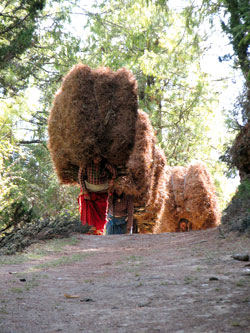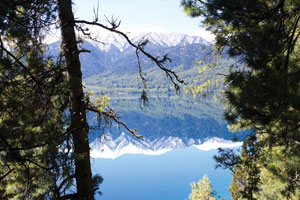 NATURE'S BOUNTY: The resplendent scenery of Rara National Park can be a source of eco-tourism revenue, but it already provides local communities with fuel like the pine needles these women from Murma are allowed to harvest. |
MUGU - An international team of experts this month completed a survey of 27 important bird areas in Nepal to see how conserving them doesn't just save nature, but can also provide income to local people.
The team included staff from the Department of National Parks and Wildlife Conservation, Bird Conservation Nepal (BCN) and the Cambridge-based BirdLife Secretariat, and they used a concept known as "eco-system service" to quantify the impact of conservation on local development.
The last of the selected sites to be surveyed was Rara National Park, where the lake is an important habitat for indigenous migratory birds. "Rara provides refuge for the globally threatened chir pheasant," explains Rara's warden, Durga Poudel, "and its pine and mixed forests are populated by red panda, musk deer and Himalayan thar."
BCN is working on a UK Government-funded Darwin Initiative project that assesses and quantifies the resources provided from nature by areas with rich birdlife. Field surveys are being carried out by the project at four sites: Shivapuri-Nagarjun National Park and Phulchoki Community Forest in Kathmandu, Kosi Tappu Wildlife Reserve and Rara National Park. The team is measuring how much carbon is being stored in the vegetation, the provision of clean water, harvesting of wild and cultivated products, and eco-tourism.
Two years ago Nepal signed the ambitious Nagoya Convention on Biological Diversity that agreed on targets for 2020 and achieving them can make a significant contribution not just to wildlife conservation but also poverty reduction and providing sustainable livelihoods to locals.
"Most poor people in Nepal live in rural areas, hence there is a high dependence on the ecosystem services delivered to them by nature like timber, water, food," explains Hum Gurung of BCN.
Gurung accompanied the international team to Rara and met park staff and buffer zone communities in Mugu. The aim was to understand how local people viewed the national park and the buffer zone, and which resources they considered important. "We wanted to see how they regard the regulations to control the use of resources, how the environment is changing, and what people see as the main threats to its biodiversity and natural resources," explains David Thomas of BirdLife International.
 PICS: HUM GURUNG |
The fieldwork in Rara National Park will also yield an estimate of how much carbon is 'locked up' in its trees. Payments for stored carbon by rich to poor countries can provide future income for communities and government agencies that protect forests. "Within five years we can re-measure the trees to see how much they have grown, and calculate how much extra carbon is being stored in parks like Rara," says assistant warden, Bhogendra Rayamajhi.
The results of the study will be presented by BCN at a conference in India later this year. Says Gurung: "We believe this research will provide new data to guide decisions on forest and park management. And will reveal how conservation can have wide ramifications for poverty-reduction, local development and the economy."
Read also:
The vultures are circling again, HUM GURUNG in NEW DELHI
South Asia registers progress in saving vultures from extinction, but more needs to be done


